Meal replacements come in powder, shake or bar form, and high-quality ones pack a healthy boost of nutrients, vitamins, and those all-important macros (carbs, proteins, fats). They are designed to keep you fueled and full when home cooking isn’t an option.
Whether you need a dairy-free, gluten-free, vegan, keto, or paleo option, there’s no shortage of meal replacements. Finding the right one to meet your dietary needs and satisfy your taste buds is all about selecting a high-quality brand, comparing ingredients, prioritizing macros, and choosing the right flavor for you.
Let's dive in.
Overview
Here's what's coming. Click on any item to jump straight to it:
Benefits
CONVENIENT: No Cooking, No Cleaning
Meal replacements keep things simple. When cooking just isn’t an option, meal replacements can act as a healthy meal substitute for time-crunched folks or can be an easy way to add nutrients and calories to your daily diet.

NUTRITIOUS: Protein Shakes vs. Meal Replacements
Protein shakes and meal replacements shakes are often confused, but the two are meant for very different purposes. To start, meal replacements contain fiber, nutrients, and a healthy balance of macros to fill and nourish your body like a complete meal should, while protein shakes are more of an extra dose of protein to supplement your diet.
Protein shakes lack calories, fiber, and other nutrients and should be in addition to meals—not in place of. Meal replacements, on the other hand, contain all the good things—protein, fiber, carbs, nutrients, vitamins, and enough calories to count as a meal.

WEIGHT LOSS: Maybe?
Many agree the first meal replacement shake ever invented was Metrecal back in 1959. At 250 calories, the beverage was marketed as a weight loss solution and paved the way for the "drink your calories" weight loss trend.
Since Metrecal, meal replacements have evolved beyond their initial weight-loss roots. Everyone from bodybuilders to hospital patients, who need to take in more calories and essential nutrients, use meal replacement shakes to gain (not loose) weight.
So will a meal replacement help you lose weight? We don't like this question because weight loss should be thought of more holistically - based on eating a diet of natural and balanced foods... not about consuming a meal replacement drink marketed for weight loss.

Considerations
MACROS: A Complete Meal, Not Only Extra Protein
A meal replacement should have a close to a balanced split of all the macronutrients - protein, carbs, fat. It should also contain fiber, valuable micro and macronutrients.
To ensure you’re buying an option that’s not just a supplement but an actual meal, read the nutrition of the product.
Generally speaking, the below nutritional breakdown is standard for meal replacement shakes:
- Carbohydrates: 20%+ (Recommended DV = 275g)
- Fat: 20%+ (Recommended DV = 78g)
- Fiber: 20%+ (Recommended DV = 28g)
- Protein: 20%+ (Recommended DV = 50g)
- Sodium: 20%+ (Recommended DV = 2,400 mg)
- Calories: 20% (Recommended DV = 2,000)
Note: The nutritional needs from person to person can differ due to age, build, and activity level, or if following a special diet (keto, low carb, high protein).
 Garden of Life Raw Organic Meal scoop into container
Garden of Life Raw Organic Meal scoop into container
CALORIES
According to the FDA, sedentary men and women burn on average 2,200 to 2,400 and 1,600 to 1,800 calories daily, respectively.
Thus, an adequate shake should have around 350-700 calories from a filling combination of healthy fats, protein, carbs - and plenty of micronutrients.
The more active you are, the more calories you’re going to need to consume.
If you’re an athlete and replacing a meal with a meal replacement shake, make sure you choose a high-calorie option. Especially if performing strenuous, calorie-torching activities like thru-hiking, long-distance running, or bodybuilding.
Curious about how many calories you burn while hiking? Check it out with this calculator.

Ka'Chava Ingredients on pack
INGREDIENTS: Keep it as natural as possible
The FDA labeling guidelines require ingredients list “in order of predominance.” Meaning, they list the ingredients in descending order from greatest to least.
Stick to meal replacements with clean ingredients you recognize and can pronounce, and opt for options that skip excessive artificial additives and preservatives.
Ingredients to consider include:
- Artificial Sweeteners: Meal replacements like to advertise how little sugar they use, but pack their meals with artificial sweeteners which can wreak havoc on the body. Common culprits are sucralose (Splenda), aspartame, saccharin (Sweet ‘N Low), acesulfame K, and sweeteners ending in ‘ol’ (eg. Sorbitol, Maltitol, Xylitol). Look for natural sweeteners instead: Monkfruit extract, honey, maple syrup, or stevia.
- Additives and Preservatives: Shelf stable meal replacements have enticing price tags, but these low-end options can do more harm to your health and digestive system than good. Avoid products that contain things like maltodextrin.
- Vitamin fortification: A lot of shakes like to “fortify” their recipes with synthetic vitamins and minerals, also known as ‘vitamin and mineral blends.’ A growing body of research suggests synthetic vitamins aren’t very nourishing at all, while others argue synthetic vitamins have zero health benefits and are even dangerous. At this point, we will leave it up to you as a personal preference.

FORMAT: Powders, Pre-mixed or Bars
Meal replacements come in three easily transportable forms: powders, pre-made drinks, or meal bars.
- Pre-made shakes are ready to go and consume as is, but they could be pricier per serving, be heavy to carry around and result in more waste.
- Mixes usually sell in bulk (so you can portion out daily servings.) With mixes, you’ll have to provide the water, or you can throw the mix in a blender alongside your favorite fruits and veggies for a more filling concoction. Light and portable. Requires more dishes/ cleaning though.
- For those who prefer to chew their calories rather than drink them, meal replacement bars are a great option.

Best Meal Replacement Powders
| Per 80 Grams | Calories | Protein (g) | Fat (g) | Fiber (g) | Sugar (g) | Price |
|---|---|---|---|---|---|---|
|
Garden of Life (RAW Meal) |
301.4 | 46.4 | 4.6 | 4.6 | 2.3 | $7.53 |
|
Huel (Vanilla v3.0) |
320.0 | 24.0 | 10.4 | 5.6 | 0.8 | $2.66 |
|
Mud Meal (Strawberry) |
400.0 | 21.0 | 25.0 | 8.0 | 4.0 | $4.68 |
|
Ka'Chava (Vanilla) |
320.0 | 33.3 | 9.3 | 12.0 | 8.0 | $6.22 |
|
Ambronite (Original) |
336.8 | 20.2 | 12.6 | 6.7 | 10.1 | $57 |
|
Ample (Original) |
444.4 | 28.9 | 31.1 | 6.7 | 2.2 | $6 |
|
Amazing Grass (Protein) |
293.3 | 53.3 | 6.7 | 5.3 | 2.7 | $6.17 |
|
VegaOne (All-in-One) |
295.7 | 43.5 | 8.7 | 12.2 | 0 | $7.53 |
|
Orgain (Original Protein) |
260.9 | 36.5 | 7.0 | 3.5 | 0 | $2.35 |
|
HLTH Code (Vanilla) |
410.3 | 27.7 | 27.7 | 9.2 | 2.1 | $4.78 |
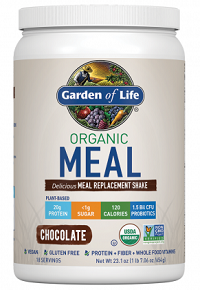
GARDEN OF LIFE
✅ Clean ingredients (no maltodextrin)
❌ 400+ Calories per 80g serving
Considered one of the healthiest powders on the market, Garden of Life Organic Meal is packed full of organic ingredients including veggies powders, fruit powders and probiotics. The powder uses a plant-based protein that is sourced from 14 legumes, seeds, and grain. It is available in chocolate and vanilla which has a neutral taste and mixes well with other flavors.
The Clean Label Project cited Garden of Life because the company's powders scored poorly in their tests for heavy metals, pesticides, and other similar contaminants. The company refuted those claims in a lengthy blog post that called into questions the methods used in the testing
Opinion: Good balance of mild taste and healthy ingredients. However, with a 100 gram serving providing a whopping 55 grams of protein and only 5 grams of fat, this is much more of a fortified protein powder than a meal replacement.
See Garden of Life
HUEL
❌ Clean ingredients (no maltodextrin)
❌ 400+ Calories per 80g serving
Huel has a similar philosophy as Soylent. It's more than just a meal replacement shake - its a new way of convenience eating. It provides 100% of the FDA's "Daily Values" of all 27 essential vitamins and minerals.
Huel aims for a more natural formula than Soylent. It is 100% vegan with plenty of protein from pea and rice as well as other natural ingredients such as oats, flaxseed, sunflower seeds, coconut and more. It's available in both a flavored and an unflavored and unsweetened version. The vanilla flavor has an oaty and light vanilla taste, while other flavors such as banana, cappuccino, and chocolate mint are bolder.
Opinion: Good. Fairly plain. Not excited that "Natural Flavors" and "Maltodextrin" are 6th and 9th most common ingredient respectively.

MUD MEAL
✅ Clean ingredients (no maltodextrin)
✅ 400+ Calories per 80g serving
Mud Meal is a complete drinkable meal that provides a lot of macros: 400 calories, 21+ grams of protein, 20+ grams of fat per serving (and under 5g of sugar).
Both flavors (vanilla and strawberry) are made of natural ingredients. If you're vegan, you'll enjoy the strawberry flavor which uses pea and hemp protein, as well as real freeze-dried strawberries.
Mud Meal tastes like a creamy shake that will keep you satiated on big hikes, runs, or as a meal replacement on a busy day.
Opinion: Obviously, we are biased. However, we are proud of our babies. Tasty, filling and clean.
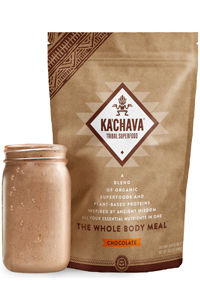
KA'CHAVA
✅ Clean ingredients (no maltodextrin)
❌ 400+ Calories per 80g serving
Ka'chava claims it is the most nutrient dense health shake available. This meal replacement powder contains 70 plant-based superfoods and nutrients. The long list of all-natural ingredients includes fiber, omega-3 fatty acids, greens, antioxidants, probiotics and proteins from yellow peas, brown rice, and sacha Inchi. Ka'chava is available in two flavors - vanilla and chocolate, both of which are sweetened with lo han fruit and stevia. At $70 per bag, Ka'chava is one of the most expensive powders on our list though.
Opinion: Very tasty. Great quality ingredients. A bit too sweet. Very expensive. More of a protein powder with supplemental ingredients than a meal replacement.
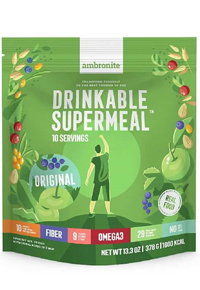
AMBRONITE
✅ Clean ingredients (no maltodextrin)
❌ 400+ Calories per 80g serving
Ambronite stands out for its simple ingredient list that uses only whole foods and no artificial flavorings, coloring or fillers. The mixture relies heavily on oats and nuts for protein and uses coconut sugar and apple to add some sweetness. Each meal-sized serving (2.5 scoops) provides 400 calories, 24g of protein, 7.5 grams of fiber, and the equivalent of 5-servings of veggies, berries, and fruit. You'll also get 20% of your daily vitamin and minerals from food-based sources, not artificial supplements.
Opinion: Good. A little veggie-esque. Extremely expensive to try ($269 for the smallest quantity?). Made in Europe which makes it hard to order to USA.
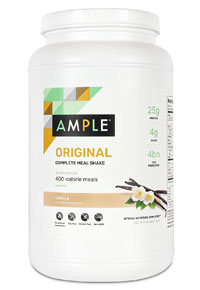
AMPLE
✅ Clean ingredients (no maltodextrin)
✅ 400+ Calories per 80g serving
Also started in Silicon Valley, Ample entered the market in 2015 as a healthier alternative to Soylent. Ample's meal replacement powder is non-GMO, gluten-free and made from quality ingredients like grass-fed whey, yellow split pea, grass-fed collagen, coconut, macadamia and organic greens. It also includes a 4 billion CFU probiotic blend.
Ample packs a mere 1g of sugar per 100 calories without sacrificing taste, a definite plus. Some may find the taste a bit chalky though compared to alternatives.
Ample gives you the option to buy their powder in bulk canisters or single-serving plastic bottles of either 400 or 600 calories. Compared with ready-to-drink options, this format is much lighter and just as convenient. Simply add water or milk, shake, and drink.
Note that Ample also offers a vegan and keto-friendly version of their powder.
Opinion: Good balanced nutritional profile. Clean ingredients. Creamy and nutty taste.

AMAZING GRASS
✅ Clean ingredients (no maltodextrin)
❌ 400+ Calories per 80g serving
Amazing Grass is by far the “greenest” veggie option on the list. The formula is known for its proprietary grass blend which includes homegrown wheat grass, barley grass, alfalfa, and kale.
The Amazing meal uses this grass mixture as a base and adds in 20 grams of plant-based protein (peanut, pea, and hemp), fiber and probiotics. Each serving provides all this goodness and two servings of fruit and veggies to boot. Amazing Grass offers it protein powder in a variety of different flavors, but it is an acquired taste.
Opinion: Great ingredients. However, tastes somewhat "like seaweed and fish food" combined. Really needs to be mixed with something to be edible. And, similar to Garden of Life, this is much more of a protein powder with supplemental ingredients.
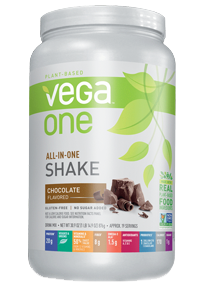
VEGA ONE
✅ Clean ingredients (no maltodextrin)
❌ 400+ Calories per 80g serving
Vega One packs 20 grams of plant-based protein (pea and seeds), 4 grams of fiber and 50% of your daily requirements of 8 vitamins and minerals into a single serving. When mixed as a shake, the powder has a distinctive green color thanks to the spinach, kale, and spirulina.
Vega One All-In-One Shake is available in two formulas - the original recipe that the company has been producing for years and a new organic formula that is receiving mixed reviews. Similar to some of the negative reviews, we tried VegaOne and couldn't choke it down due to the strong artificial metallic flavor.
Opinion: Very strange and strong metallic taste. And, yet again, this is more of a protein powder than a meal replacement. No thanks.

ORGAIN
✅ Clean ingredients (no maltodextrin)
❌ 400+ Calories per 80g serving
Orgain not only says it is organic, but it backs up that claim with USDA organic certification. The company uses only organic protein, veggies, and greens in its meal replacement powder. The powder gets it protein from plant-based sources with the bulk coming from pea, brown rice, and chia seed. It also includes a sprout, veggie, fruit, and greens blend for added nutrition. Orgain is available in a chocolate and vanilla bean flavors. The mixture is sugar-free, but it does use erythritol for a sweetener.
Opinion: Similar to VegaOne. Nice ingredients. Way too many weird sweeteners though. Gross.

HLTH CODE
❌ Clean ingredients (no maltodextrin)
✅ 400+ Calories per 80g serving
A metabolic scientist named Dr. Ben Bikman created HLTH. It’s a 400-calorie, keto-friendly meal replacement shake made with non-GMO products. HLTH is unique because of its 1:1 ratio (27 grams each) of fats and protein. The fats come from coconut oil, olive oil, MCT oil, cocoa butterfat, and grass-fed ghee, and the protein’s a mixture of whey concentrate, grass-fed collagen, and egg whites. Dr. Bikman’s theory on the 1:1 ratio mimics the world’s most nutritious foods that have a similar makeup, as he believes a 50/50 split of fat and protein improves many health factors like cardiovascular health and hypertension.
Opinion: Creamy, good, a bit of a lingering stevia after-taste. Ingredients are decent. Could do without maltodextrin and a few others though.
Can You Live Off Of Meal Replacements?
Short answer: you could survive, but not thrive.
There is a lot of debate around this. We don't recommend living off of meal replacements entirely though. A balanced diet from a variety of whole food sources should the goal. Meal replacements can help when time is tight.
For reference, in 2014, a man named Nick Harding tried doing to live off of meal replacement products for seven days and wrote about his experiences.
He noted headaches, body shakes, hunger, weakness, low energy, dizziness, digestion problems, and a lot of flatulence (nice). When the seven days were up, Harding ran another blood test which found reduced levels of phosphates (a sign of malnutrition).

The last round of sampling
Protein Sources: Plant-Based vs Animal
Protein is an essential macronutrient that helps build and repair muscles, curb hunger and keep our bones, organs, skin, and hair healthy.
Since our bodies can’t produce the nine essential amino acids it needs (amino acids are what gets left behind after protein is digested), it’s important to consume foods that contain them.
So, is a plant or animal-based protein best? Again, this is a very heated topic. Many debate the advantages and disadvantages of plant-based and animal-based protein sources. Here’s a further look at each.
PLANT-BASED PROTEINS (GENERAL SUMMARY)
Advantages:
- Easier to digest
- High in fiber
- Rich in antioxidants, vitamins, minerals, and nutrients
- Low cholesterol and saturated fats
Disadvantages:
- Most plant proteins are 'incomplete' alone
- Harder to get adequate B-12
- May take longer to digest
- Can be pricier

Sources:
SOY: Soybeans are ground and processed to produce soy protein isolate that’s 90% protein. Like whey, soy contains nine essential amino acids. It’s often supplemented and flavored for improved taste and texture. (Note: avoid if you have a soy allergy.)
PEA: Great for vegans or those with lactose intolerance or other allergens, this plant-derived dried powder is extracted from split peas. It has all nine essential amino acids and is used in energy bars, veggie burgers, and sold as a powder. It is low in methionine, and shouldn’t be used as a sole protein source.
BROWN RICE: A vegan/vegetarian protein powder extracted from brown rice and rice protein that’s easily digested and hypoallergenic, making it a good choice for those with food allergies. Unlike soy and whey, brown rice lacks amino acids and isn’t a complete protein.
HEMP: A superfood because of its fatty acids, fiber content, and antioxidants, hemp comes from cannabis plant seeds. It has a nutty, earthy taste and gritty texture, in part because it's not highly processed. Hemps is a more expensive protein due to its association with cannabis, and contains low levels of all nine essential amino acids, and shouldn’t be your only protein source.
SACHA INCHI: Another superfood protein, Sacha Inchi is a plant seed from the rain forests of South America. The seeds are rich in Omega-3 fatty acids, vitamin A, E, calcium, zinc, potassium, and tryptophan. They’re first pressed for oil, and any seed waste is used as protein powder.
PEANUT: A popular, powdered protein source that’s widely available and inexpensive, powdered peanut butter comes from roasted peanuts that are pressed for oil, then ground into a powder. With the oil removed, powdered peanut butter is lower in calories than regular peanut butter. When reconstituted with water, powdered peanut butter has a different taste and texture than peanut butter. It’s great for shakes, not so great as a spread.

ANIMAL PROTEIN
Advantages:
- Most animal proteins are complete proteins
- High levels of iron and B-12
- A small quantity of meat contains a high amount of protein
Disadvantages:
- High in saturated fats and cholesterol
- Lacking fiber
- Doesn’t include as many antioxidants as plant-based protein
- Studies found animal protein may be linked to increased risk of cardiovascular disease and high blood pressure
Sources:
WHEY: Whey is a processed animal protein that’s derived from the liquid part of milk that separates while making cheese. It’s low in lactose and contains all nine essential amino acids. You can easily add 25-50 grams of protein to your diet with whey, just be sure to check the ingredients label for artificially sweetened mixes.
CASEIN: A dairy-based protein source that comes from milk. Unlike whey, it’s a slow-digesting protein, meaning it’s likely to keep you full for longer compared to a fast-digesting protein. This makes it a popular choice for breakfasts.
EGG: A lactose-free, minimally processed, and easily digestible protein derived from… you guessed it, eggs! Egg whites, anyway. They’re first dehydrated and then turned into powder. Egg protein has all nine essential amino acids making it a complete protein.
📸 Some photos in this post were taken by Jonathan Davis (@meowhikes)






 650-Calorie Fuel
650-Calorie Fuel